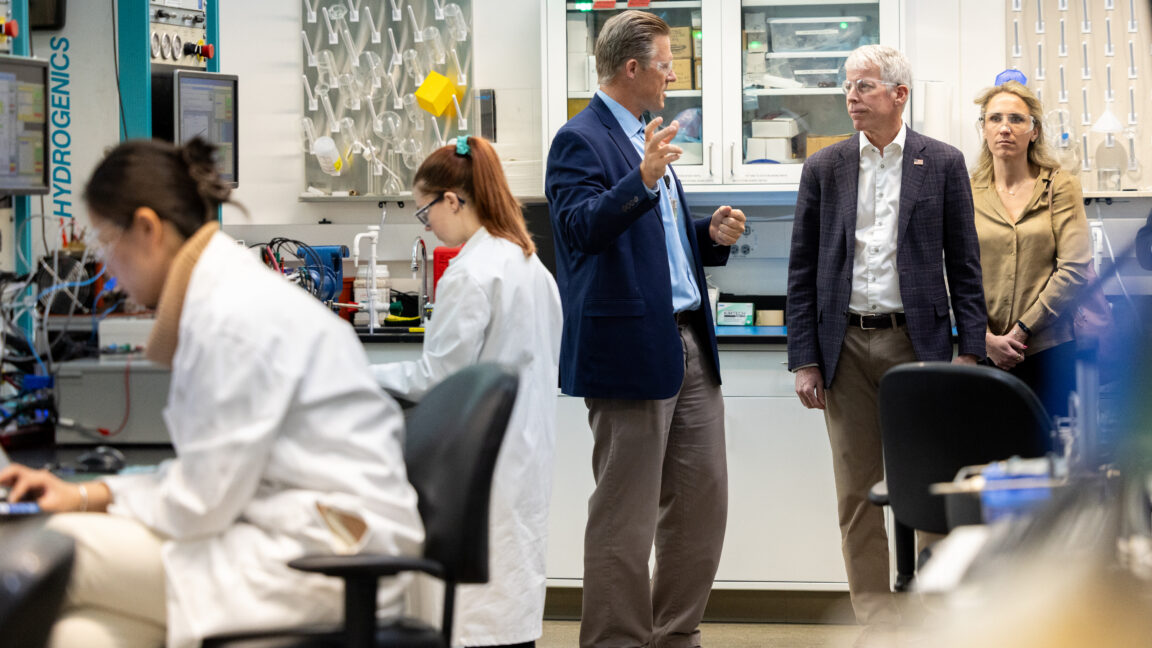The Trump administration has renamed the National Renewable Energy Laboratory, now calling it the National Laboratory of the Rockies, marking an identity shift for the Colorado institution that has been a global leader in wind, solar and other renewable energy research.
“The new name reflects the Trump administration’s broader vision for the lab’s applied energy research, which historically emphasized alternative and renewable sources of generation, and honors the natural splendor of the lab’s surroundings in Golden, Colorado,” said Jud Virden, laboratory director, in a statement.
He did not specify what this “broader vision” would mean for the lab’s programs or its staff of about 4,000.
The renaming is the latest in a series of actions by the Trump administration to deemphasize or cut the parts of the federal government that support renewable energy, while also expanding federal support for fossil fuels.
Asked for details, the Department of Energy said in an email that the renaming “reflects the Department’s renewed focus on ‘energy addition’ rather than the prioritization of specific energy resources.”
A lab spokesman had no additional information about whether there will be changes to programs or headcount at the lab.
Bill Ritter, a Democrat who was governor of Colorado from 2007 to 2011, said it’s reasonable to assume that the name change signals that the federal government is abandoning the lab’s status as a world leader in energy research.
“It’s an iconic research facility,” he said.
Underscoring this point, he recalled a trip to Israel while he was governor.
“The head of their renewable energy laboratory said, ‘I have nothing to tell you because you come from the place that has the best renewable energy laboratory in the world,’” Ritter said.
After leaving office, he founded the Center for the New Energy Economy at Colorado State University, which specializes in energy policy research and is now a consultant on energy business and policy.
Based on this experience, he thinks that anything the Trump administration does to divert from the lab’s mission is harmful to the United States’ ability to remain a major player in the energy economy of the near future.
“We’ll no longer be competitive in renewables research with China or India or other countries that are still heading toward the renewable energy transition at a very fast pace,” he said.
People with close ties to the lab were not surprised by the name change, given the administration’s broader goals.
“In the early days of DOGE, people there were whispering about a name change to avoid the ire of MAGAs,” said Matt Henry, a Montana-based social scientist who worked at the lab from February 2024 to August 2025, in a post on Bluesky. “It pissed me off—prioritizing the preservation of the institution at the expense of its [stated] mission? So disappointing.”
He was referring to Elon Musk’s Department of Government Efficiency, which sought to cut federal spending in the early months of the Trump administration. The term MAGA refers to Trump’s “Make America Great Again” slogan and movement.
Dustin Mulvaney, a San Jose State University environmental studies professor, said if the name change is a sign of a significant change in the lab’s work, it would be “like losing several major land grant research universities all at once.”
Mulvaney has done projects in partnership with people at the lab. An important part of the institution’s work, he said, is that its research is free and accessible to the public, helping businesses and universities that may not be able to afford the work of private research firms.
The lab’s mission has included consulting to help communities benefit from new energy technologies and ensure smooth transitions away from fossil fuels.
This work meant that the lab was out of step with an administration that has said it disagrees with the idea of a transition away from fossil fuels and has sought to impede funding and development of renewable energy.
The lab was established in 1974 as the Solar Energy Research Institute, part of a law signed by President Gerald Ford to facilitate alternatives to importing oil from the Middle East, according to a history on the lab’s website. The US was suffering through high gasoline prices amid tensions with oil-producing nations such as Saudi Arabia.
“The energy crisis we face today is unlike the crisis that gave rise to NREL,” said Audrey Robertson, assistant secretary of energy, in a statement. “We are no longer picking and choosing energy sources. Our highest priority is to invest in the scientific capabilities that will restore American manufacturing, drive down costs, and help this country meet its soaring energy demand.”
In 1977, the federal government selected Golden, Colorado, as the location for the lab. In 1991, the Solar Energy Research Institute became the National Renewable Energy Laboratory, part of a change by the administration of President George H. W. Bush that also elevated the institution to become part of the country’s national lab system.
But the lab’s history has also included budget cuts and periods when its work fell out of favor with presidential administrations, including layoffs and funding cuts under President Ronald Reagan. President Donald Trump proposed substantial cuts during his first term, but Congress retained much of the funding.
The Trump administration’s budget proposal, issued in May, calls for cuts across non-defense discretionary spending, including on energy research, but the budget process is still underway.
This article originally appeared on Inside Climate News, a nonprofit, non-partisan news organization that covers climate, energy and the environment. Sign up for their newsletter here.






